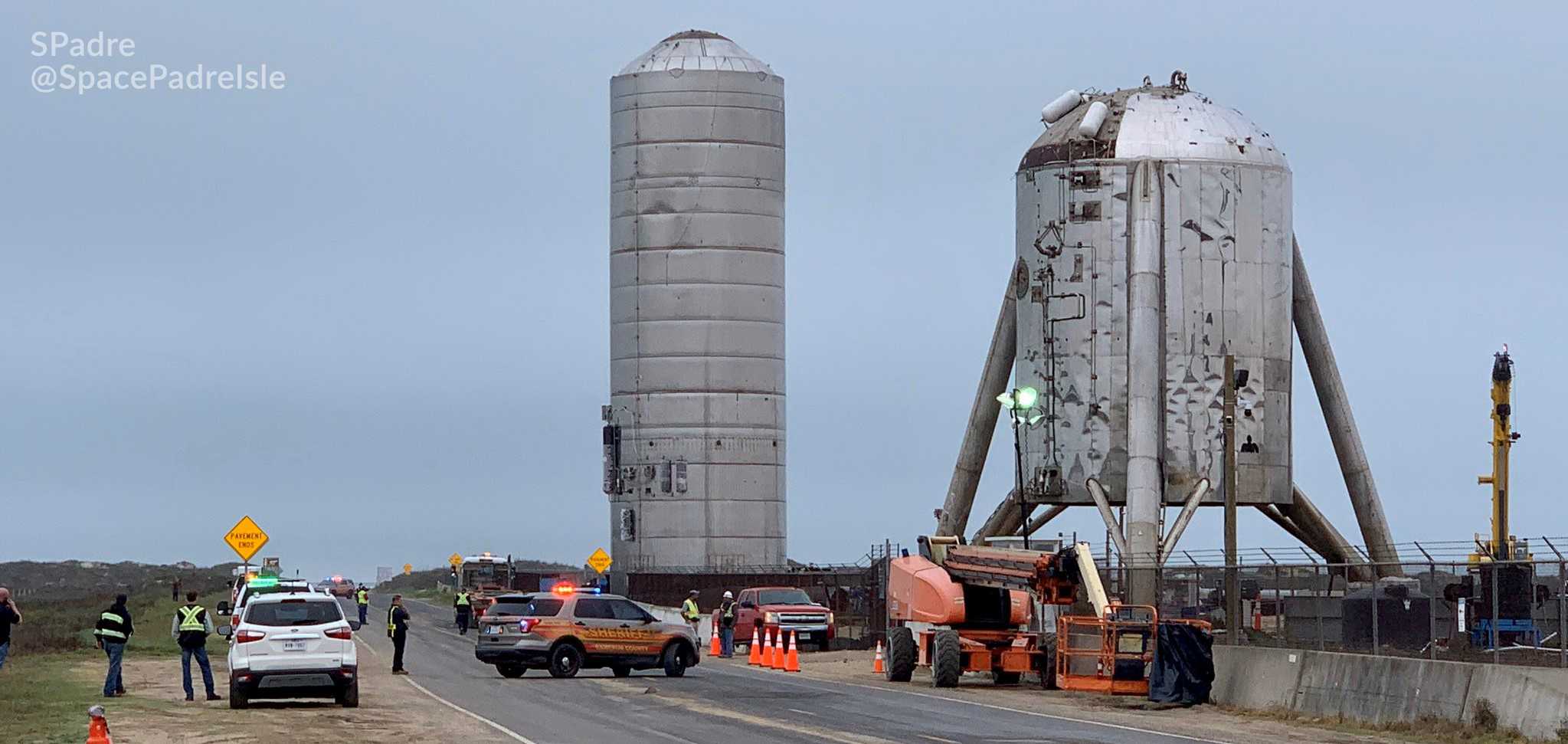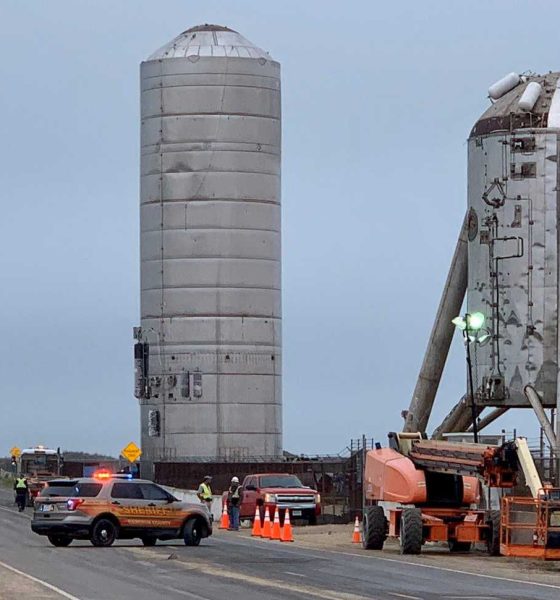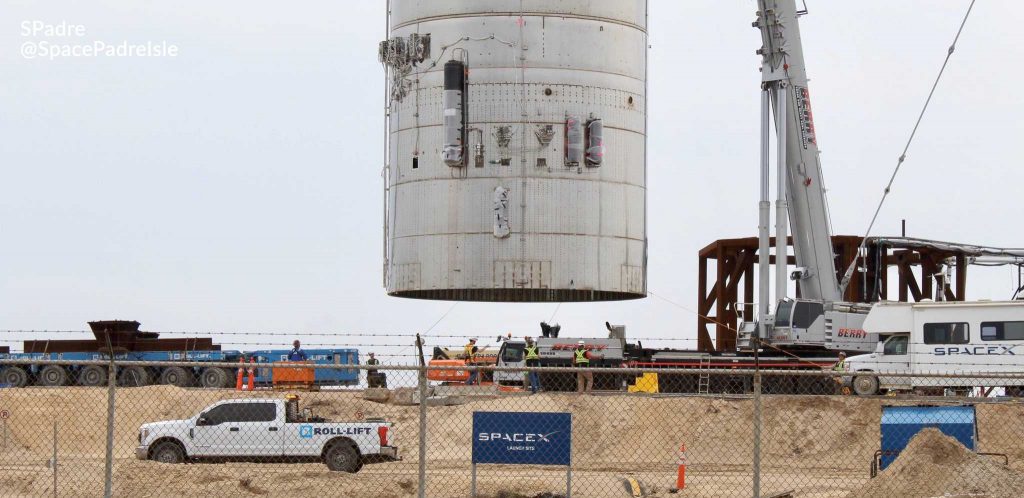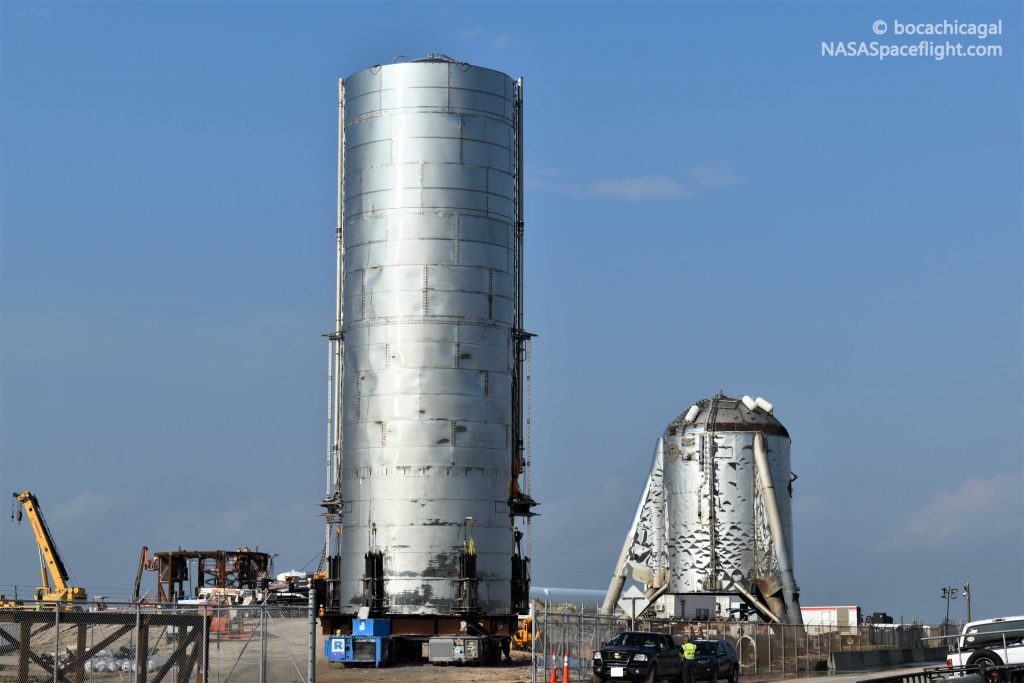

News
SpaceX Starship rolls to Texas launch pad ahead of next big test campaign
SpaceX’s first flightworthy Starship prototype has rolled to its South Texas launch pad just hours after it was welded together and is now preparing for several critical tests it must pass before it can be deemed ready for liftoff.
Fabricated and assembled with incredible speed at SpaceX’s growing Boca Chica, Texas Starship factory and test facilities, the vehicle SpaceX moved to the launch pad earlier today (Feb 25) is meant to become the first full-scale Starship prototype to take flight. Following in the footsteps of the Starship Mk1 prototype, deemed too shoddy to launch and pressurized to destruction in November 2019, the first serial build (SN01) of an improved line of Starship prototypes appears to have taken less than a month to go from first weld to the launch pad.
CEO Elon Musk took to Twitter earlier today to confirm the Starship SN01 tank section’s move to the launch pad, further noting that the tank assembly is now preparing for Raptor engine installation ahead of a static fire test. According to NASASpaceflight.com, SpaceX wants to complete that static fire and launch Starship SN01 as early as next month – a seemingly improbable target that just got much more likely with the rocket’s tank section already at the launch pad. Most importantly, however, the speed with which SpaceX has been able to assemble and prepare Starship SN01 suggests that even if things go wrong or plans change, another completed prototype could be ready to head to the pad just a few weeks from now.
On February 25th, SpaceX CEO Elon Musk posted a screenshot taken from a livestream created by SPadre earlier that day, noting that Starship will soon have engines installed in preparation for a critical static fire test.

Under the cover of an incredibly thick fog bank, Starship SN01 was lifted onto a Roll Lift transporter and carefully moved from its factory facilities to SpaceX’s Boca Chica launch pad at 4:30 am PST. Around 7:30 am PST, the giant rocket tank was lifted onto the pad’s Starship mount and technicians have been working to connect SN01 to the ground systems ever since.
Built out of stainless steel, Starship SN01’s tank section – referring to the combined liquid oxygen tank, liquid methane tank, and engine section – stands about 30m (100 ft) tall and likely weighs at least 30-45 metric tons (~70,000-100,000 lb) as it stands. While SN01 is clearly missing its pointed nose section (‘nosecone’) and flaps, among other parts, its tank section has been moved to the launch pad to perform tests that don’t involve the ship’s aerodynamic properties.
Starship Mk1 – SpaceX’s first attempt at a full-scale prototype – was fabricated and stacked piece by piece over the course of nine months before its tank section – looking almost identical to SN01 – first rolled to SpaceX’s launch pad on October 30th, 2019. Three weeks later, it was intentionally pressurized until it popped after engineers concluded that its production quality was too low for a flight test attempt to be worth the effort. On the other hand, the first of Starship SN01’s steel rings was definitively completed in the last week of January 2020, quite possibly just four weeks before the completed tank section was rolled to the same launch pad.
With that kind of speed, it’s no surprise that Musk says SpaceX will start stacking Starship SN02’s tank section this week. Intriguingly, Musk also stated that Starship SN02 would have three Raptors installed, avoiding the original question’s focus (SN01). As such, it appears that Starship SN01 may only have one Raptor installed for a static fire test and would be unlikely to ever fly if that were the case. It’s possible that after two highly successful (and explosive) pressure tests of smaller Starship test tanks that were completed last month, SpaceX still wants to perform a similar pressure test with a fully-integrated, full-scale Starship tank section to confirm that the smaller tank results carry over.

Whether SN01 is still destined for flight, it’s safe to say that Starship SN01 tank testing could begin in a matter of days — SpaceX currently has early-morning roadblocks indicative of such testing scheduled from February 29th to March 2nd. SpaceX is likely to kick off by filling SN01 with water to check its tanks for leaks, followed by liquid nitrogen – chemically neutral but still incredibly cold. After that, SN01 would likely graduate to Raptor engine installation and a wet dress rehearsal (WDR) with liquid oxygen and methane before moving on to a static fire attempt, if all goes well.
Check out Teslarati’s Marketplace! We offer Tesla accessories, including for the Tesla Cybertruck and Tesla Model 3.

News
Tesla China delivery centers look packed as 2025 comes to a close
Needless to say, it appears that Tesla China seems intent on ending 2025 on a strong note.

Tesla’s delivery centers in China seem to be absolutely packed as the final days of 2025 wind down, with photos on social media showing delivery locations being filled wall-to-wall with vehicles waiting for their new owners.
Needless to say, it appears that Tesla China seems intent on ending 2025 on a strong note.
Full delivery center hints at year-end demand surge
A recent image from a Chinese delivery center posted by industry watcher @Tslachan on X revealed rows upon rows of freshly prepared Model Y and Model 3 units, some of which were adorned with red bows and teddy bears. Some customers also seem to be looking over their vehicles with Tesla delivery staff.
The images hint at a strong year-end push to clear inventory and deliver as many vehicles as possible. Interestingly enough, several Model Y L vehicles could be seen in the photos, hinting at the demand for the extended wheelbase-six seat variant of the best-selling all-electric crossover.
Strong demand in China
Consumer demand for the Model Y and Model 3 in China seems to be quite notable. This could be inferred from the estimated delivery dates for the Model 3 and Model Y, which have been extended to February 2026 for several variants. Apart from this, the Model Y and Model 3 also continue to rank well in China’s premium EV segment.
From January to November alone, the Model Y took China’s number one spot in the RMB 200,000-RMB 300,000 segment for electric vehicles, selling 359,463 units. The Model 3 sedan took third place, selling 172,392. This is quite impressive considering that both the Model Y and Model 3 are still priced at a premium compared to some of their rivals, such as the Xiaomi SU7 and YU7.
With delivery centers in December being quite busy, it does seem like Tesla China will end the year on a strong note once more.
News
Tesla Giga Berlin draws “red line” over IG Metall union’s 35-hour week demands
Factory manager André Thierig has drawn a “red line” against reducing Giga Berlin’s workweek to 35 hours, while highlighting that Tesla has actually increased its workers’ salaries more substantially than other carmakers in the country.

Tesla Giga Berlin has found itself in a new labor dispute in Germany, where union IG Metall is pushing for adoption of a collective agreement to boost wages and implement changes, such as a 35-hour workweek.
In a comment, Giga Berlin manager André Thierig drew a “red line” against reducing Giga Berlin’s workweek to 35 hours, while highlighting that Tesla has actually increased its workers’ salaries more substantially than other carmakers in the country.
Tesla factory manager’s “red line”
Tesla Germany is expected to hold a works council election in 2026, which André Thierig considers very important. As per the Giga Berlin plant manager, Giga Berlin’s plant expansion plans might be put on hold if the election favors the union. He also spoke against some of the changes that IG Metall is seeking to implement in the factory, like a 35-hour week, as noted in an rbb24 report.
“The discussion about a 35-hour week is a red line for me. We will not cross it,” Theirig said.
“(The election) will determine whether we can continue our successful path in the future in an independent, flexible, and unbureaucratic manner. Personally, I cannot imagine that the decision-makers in the USA will continue to push ahead with the factory expansion if the election results favor IG Metall.”
Giga Berlin’s wage increase
IG Metall district manager Jan Otto told the German news agency DPA that without a collective agreement, Tesla’s wages remain significantly below levels at other German car factories. He noted the company excuses this by referencing its lowest pay grade, but added: “The two lowest pay grades are not even used in car factories.”
In response, Tesla noted that it has raised the wages of Gigafactory Berlin’s workers more than their German competitors. Thierig noted that with a collective agreement, Giga Berlin’s workers would have seen a 2% wage increase this year. But thanks to Tesla not being unionized, Gigafactory Berlin workers were able to receive a 4% increase, as noted in a CarUp report.
“There was a wage increase of 2% this year in the current collective agreement. Because we are in a different economic situation than the industry as a whole, we were able to double the wages – by 4%. Since production started, this corresponds to a wage increase of more than 25% in less than four years,” Thierig stated.
News
Tesla is seeing a lot of momentum from young Koreans in their 20s-30s: report
From January to November, young buyers purchased over 21,000 Teslas, putting it far ahead of fellow imported rivals like BMW and Mercedes-Benz.

Tesla has captured the hearts of South Korea’s 20s-30s demographic, emerging as the group’s top-selling imported car brand in 2025. From January to November, young buyers purchased over 21,000 Teslas, putting it far ahead of fellow imported rivals like BMW and Mercedes-Benz.
Industry experts cited by The Economist attributed this “Tesla frenzy” to fandom culture, where buyers prioritize the brand over traditional car attributes, similar to snapping up the latest iPhone.
Model Y dominates among young buyers
Data from the Korea Imported Automobile Association showed that Tesla sold 21,757 vehicles to the 20s-30s demographic through November, compared to BMW’s 13,666 and Mercedes-Benz’s 6,983. The Model Y led the list overwhelmingly, with variants like the standard and Long Range models topping purchases for both young men and women.
Young men bought around 16,000 Teslas, mostly Model Y (over 15,000 units), followed by Model 3. Young women followed a similar pattern, favoring Model Y (3,888 units) and Model 3 (1,083 units). The Cybertruck saw minimal sales in this group.
The Model Y’s appeal lies in its family-friendly SUV design, 400-500 km range, quick acceleration, and spacious cargo, which is ideal for commuting and leisure. The Model 3, on the other hand, serves as an accessible entry point with lower pricing, which is valuable considering the country’s EV subsidies.
The Tesla boom
Experts described Tesla’s popularity as “fandom culture,” where young buyers embrace the brand despite criticisms from skeptics. Professor Lee Ho-geun called Tesla a “typical early adopter brand,” comparing purchases to iPhones.
Professor Kim Pil-soo noted that young people view Tesla more as a gadget than a car, and they are likely drawn by marketing, subsidies, and perceived value. They also tend to overlook news of numerous recalls, which are mostly over-the-air software updates, and controversies tied to the company.
Tesla’s position as Korea’s top import for 2025 seems secured. As noted by the publication, Tesla’s December sales figures have not been reported yet, but market analysts have suggested that Tesla has all but secured the top spot among the country’s imported cars this year.








